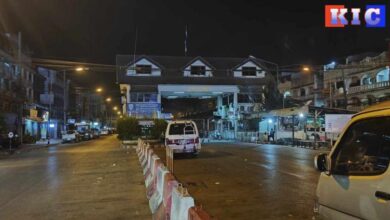Despite pilot project, displaced villagers still wary of Burma Army

Karen humanitarian groups working with a Norwegian non-government-organization, as part of the Myanmar Peace Support Initiative, plan to start its second phase of a pilot project designed to help displaced Karen people in eastern Burma.
The Karen National Union’s Committee for Internally Displaced Karen People (CIDKP), the Karen Office of Relief and Development (KORD) and the Norwegian People’s Aid run the Kyauk Gyi Pilot Project. The project also has the support of both the Karen National Union and the Burma government.
Saw Kyaw Ber, CIDKP’s coordinator for Kyauk Gyi Pilot Project spoke to Karen News.
“We have now finished the first phase of the pilot, and we are ready for the next phase. This will not be delivering relief,as in the first stage, but we will now concentrate on supporting IDPs to restart their lives.”
“We will help and support IDPs to return to their original villages. We will help them to cultivate their farms, provide them with the needed tools and materials to restart their life.”
The Kyauk Gyi Pilot project started in August 2012 to provide humanitarian assistance to Karen civilians displaced by conflict. The pilot project was agreed to by both the KNU and the Burma government a cease-fire and agreement by both sides to continue a peace process. The Kyauk Gyi Pilot Project is implement by CIDKP, KORD and the Norwegian People’s Aid (NPA). The Kyauk Gyi Pilot Project delivers humanitarian assistance to the displaced people.
CIDKP implemented the first phase of the Kyauk Gyi Pilot project in Keh Der village track, 20 miles from Kyauk Gyi town in Bago Division. CIDKP estimate that there are 1,585 internally displaced Karen people or 224 households living in jungle hideouts in Keh Der village track.
CIDKP spokesperson said the project initially ran into difficulties when the Burma Army caused problems for the displaced Karen people.
Kyaw Ber from the CIDKP’s explained.
“When IDPs used to come to get relief from us they were interrogated by the Burma Army. The villagers complained to us about this and we talked to the Burma Army to get them to stop harassing villagers. We saw this as a positive change in the Army’s behavior.”
“People (in conflict) areas are now more free to move around,” said Kyaw Ber.
Keh Der village track is made up of 12 villages, comprised of two distinct group of villagers who fled the Burma Army offensives from two different locations.
Despite more than a year since the cease-fire agreement between the KNU and the Burma government, Karen internally displaced people still lack the confidence to return to their homes. The displaced people say the main obstacle is that Burma Army bases still operate in and around the villages fled.
Kyaw Ber said that the Burma Army camps located close to villages is a major concern for villagers when considering their options.
“In the plains area less than 10% of displaced people have started to return to their original villages, about 50 % of IDPs from mountain areas have return to their villages. IDPs from the plain areas still fear returning because of the closeness of the Burma Army bases to their villages.”
“CIDKP has informed the KNU leaders on a number of occasions about the Burma Army bases being too close near to villages. So far there has not been any response to our or the villagers concerns. ”
Villagers in Keh Der village track have been on the run from Burma Army offensives since 1976. The Border Consortium has estimated that more than 3,600 villages in south-eastern Burma have been destroyed or abandoned since 1976 because of militarization.




